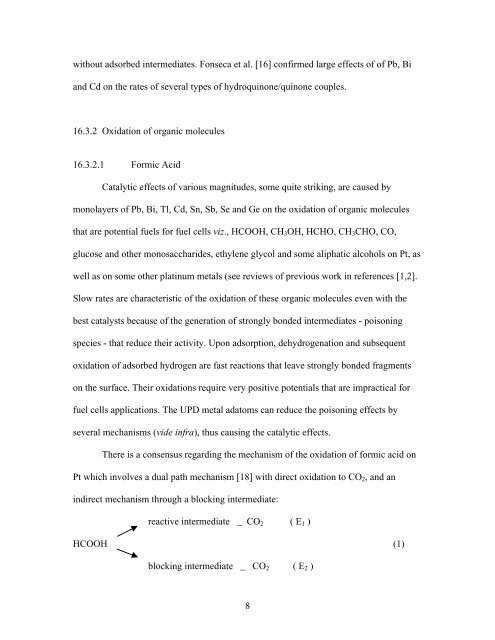electrocatalysis on surfaces modified... - Brookhaven National ...
electrocatalysis on surfaces modified... - Brookhaven National ...
electrocatalysis on surfaces modified... - Brookhaven National ...
Create successful ePaper yourself
Turn your PDF publications into a flip-book with our unique Google optimized e-Paper software.
without adsorbed intermediates. F<strong>on</strong>seca et al. [16] c<strong>on</strong>firmed large effects of of Pb, Bi<br />
and Cd <strong>on</strong> the rates of several types of hydroquin<strong>on</strong>e/quin<strong>on</strong>e couples.<br />
16.3.2 Oxidati<strong>on</strong> of organic molecules<br />
16.3.2.1 Formic Acid<br />
Catalytic effects of various magnitudes, some quite striking, are caused by<br />
m<strong>on</strong>olayers of Pb, Bi, Tl, Cd, Sn, Sb, Se and Ge <strong>on</strong> the oxidati<strong>on</strong> of organic molecules<br />
that are potential fuels for fuel cells viz., HCOOH, CH 3 OH, HCHO, CH 3 CHO, CO,<br />
glucose and other m<strong>on</strong>osaccharides, ethylene glycol and some aliphatic alcohols <strong>on</strong> Pt, as<br />
well as <strong>on</strong> some other platinum metals (see reviews of previous work in references [1,2].<br />
Slow rates are characteristic of the oxidati<strong>on</strong> of these organic molecules even with the<br />
best catalysts because of the generati<strong>on</strong> of str<strong>on</strong>gly b<strong>on</strong>ded intermediates - pois<strong>on</strong>ing<br />
species - that reduce their activity. Up<strong>on</strong> adsorpti<strong>on</strong>, dehydrogenati<strong>on</strong> and subsequent<br />
oxidati<strong>on</strong> of adsorbed hydrogen are fast reacti<strong>on</strong>s that leave str<strong>on</strong>gly b<strong>on</strong>ded fragments<br />
<strong>on</strong> the surface. Their oxidati<strong>on</strong>s require very positive potentials that are impractical for<br />
fuel cells applicati<strong>on</strong>s. The UPD metal adatoms can reduce the pois<strong>on</strong>ing effects by<br />
several mechanisms (vide infra), thus causing the catalytic effects.<br />
There is a c<strong>on</strong>sensus regarding the mechanism of the oxidati<strong>on</strong> of formic acid <strong>on</strong><br />
Pt which involves a dual path mechanism [18] with direct oxidati<strong>on</strong> to CO 2 , and an<br />
indirect mechanism through a blocking intermediate:<br />
reactive intermediate _ CO 2 ( E 1 )<br />
HCOOH (1)<br />
blocking intermediate _ CO 2 ( E 2 )<br />
8
















